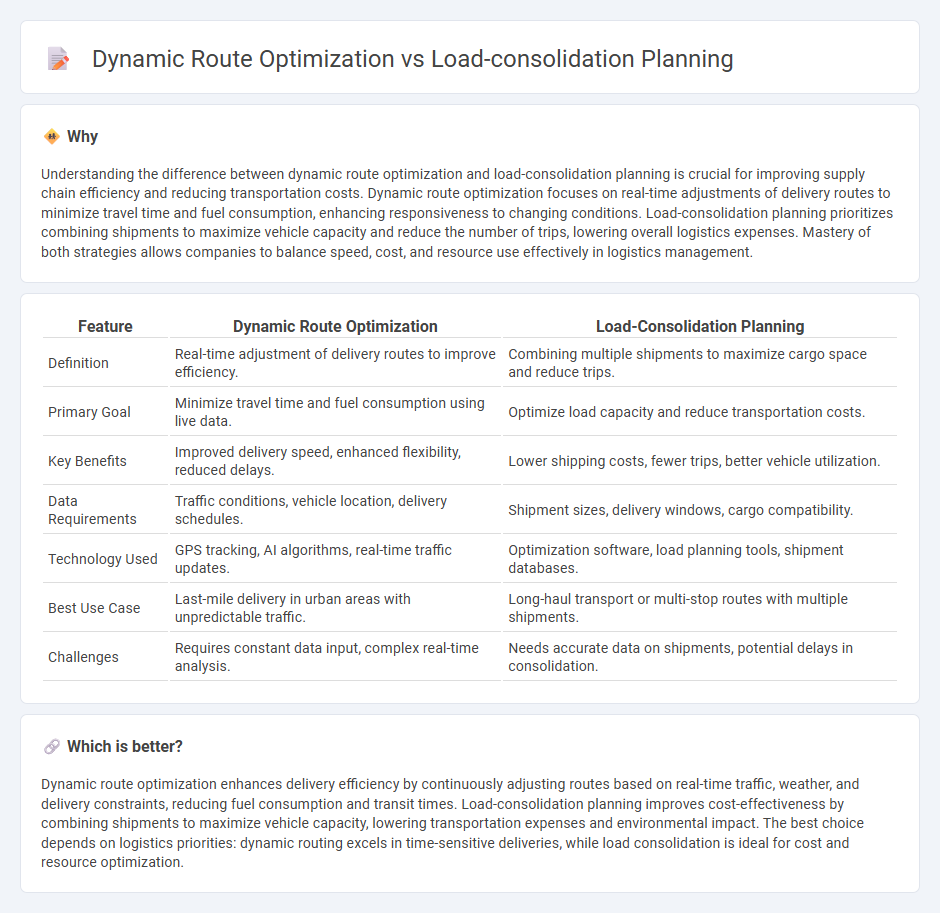
Dynamic route optimization leverages real-time data and advanced algorithms to adjust delivery paths on the fly, reducing fuel consumption and improving delivery speed. Load-consolidation planning focuses on grouping shipments efficiently to maximize vehicle capacity and minimize transportation costs. Explore how these strategies transform logistics efficiency and sustainability.
Why it is important
Understanding the difference between dynamic route optimization and load-consolidation planning is crucial for improving supply chain efficiency and reducing transportation costs. Dynamic route optimization focuses on real-time adjustments of delivery routes to minimize travel time and fuel consumption, enhancing responsiveness to changing conditions. Load-consolidation planning prioritizes combining shipments to maximize vehicle capacity and reduce the number of trips, lowering overall logistics expenses. Mastery of both strategies allows companies to balance speed, cost, and resource use effectively in logistics management.
Comparison Table
| Feature | Dynamic Route Optimization | Load-Consolidation Planning |
|---|---|---|
| Definition | Real-time adjustment of delivery routes to improve efficiency. | Combining multiple shipments to maximize cargo space and reduce trips. |
| Primary Goal | Minimize travel time and fuel consumption using live data. | Optimize load capacity and reduce transportation costs. |
| Key Benefits | Improved delivery speed, enhanced flexibility, reduced delays. | Lower shipping costs, fewer trips, better vehicle utilization. |
| Data Requirements | Traffic conditions, vehicle location, delivery schedules. | Shipment sizes, delivery windows, cargo compatibility. |
| Technology Used | GPS tracking, AI algorithms, real-time traffic updates. | Optimization software, load planning tools, shipment databases. |
| Best Use Case | Last-mile delivery in urban areas with unpredictable traffic. | Long-haul transport or multi-stop routes with multiple shipments. |
| Challenges | Requires constant data input, complex real-time analysis. | Needs accurate data on shipments, potential delays in consolidation. |
Which is better?
Dynamic route optimization enhances delivery efficiency by continuously adjusting routes based on real-time traffic, weather, and delivery constraints, reducing fuel consumption and transit times. Load-consolidation planning improves cost-effectiveness by combining shipments to maximize vehicle capacity, lowering transportation expenses and environmental impact. The best choice depends on logistics priorities: dynamic routing excels in time-sensitive deliveries, while load consolidation is ideal for cost and resource optimization.
Connection
Dynamic route optimization enhances logistics efficiency by continuously adjusting delivery paths based on real-time data such as traffic conditions and shipment priorities. Load-consolidation planning maximizes vehicle capacity by strategically grouping shipments, reducing transportation costs and emissions. Integrating these two approaches enables logistics providers to create adaptive, cost-effective routes that optimize resource utilization and improve overall supply chain performance.
Key Terms
**Load-Consolidation Planning:**
Load-consolidation planning optimizes shipment efficiency by grouping multiple smaller loads into a single transportation unit, reducing overall shipping costs and minimizing environmental impact. This approach improves vehicle utilization rates and lowers the frequency of trips, driving significant savings in fuel consumption and emissions. Discover how load-consolidation planning can streamline your logistics and enhance supply chain sustainability.
Palletization
Load-consolidation planning enhances pallet utilization by systematically grouping shipments to maximize pallet space and reduce transportation costs. Dynamic route optimization adjusts delivery routes in real-time to improve efficiency while accommodating pallet load constraints and time-sensitive deliveries. Explore how integrating palletization with these strategies can revolutionize your supply chain effectiveness.
Cubic Utilization
Load-consolidation planning maximizes cubic utilization by strategically grouping shipments to fill container volume efficiently, reducing wasted space and transportation costs. Dynamic route optimization adjusts delivery paths in real-time to accommodate new orders and traffic conditions but may sacrifice cubic utilization for speed and flexibility. Explore how combining these approaches can enhance overall efficiency in logistics operations.
Source and External Links
Load Consolidation Strategies | Freight Glossary - UNIS - Load-consolidation planning involves combining multiple smaller shipments into a single larger shipment using techniques like freight auditing, transportation management systems, and load planning software to significantly reduce costs and improve supply chain efficiency.
Load Consolidation: Outbound Transportation Opportunities - Load consolidation opportunities can be identified by analyzing load profiles, load tiers, item mirroring across distribution centers, and customer clusters to merge smaller shipments into full truckloads for cost-effective logistics.
Load Planning: Strategy for Faster & Cheaper Deliveries - Load consolidation in planning ensures vehicles leave as full as possible by combining shipments that might otherwise go out separately, optimizing route efficiency and delivery timing for cost savings and faster service.
 dowidth.com
dowidth.com